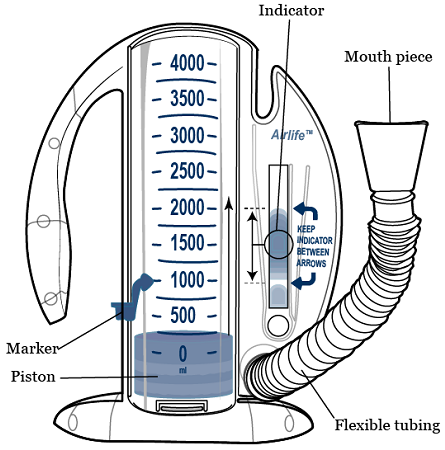

How To Use Your Incentive Spirometer
The first time you use your incentive spirometer, you will need to take the flexible tubing with the mouthpiece out of the bag. Stretch out the tubing and connect it to the outlet on the right side of the base (see Figure 1). The mouthpiece will be attached to the other end of the tubing.
When you’re using your incentive spirometer, make sure to breathe through your mouth. If you breathe through your nose, the incentive spirometer won’t work properly. You can hold your nose if you have trouble. If you feel dizzy at any time, stop and rest. Try again at a later time.
Demonstration Videos

SPECIFICATIONS
About Your Incentive Spirometer
An incentive spirometer is a device that will expand your lungs by helping you to breathe more deeply and fully. The parts of your incentive spirometer are labeled in Figure 1.

Figure 1. Incentive Spirometer
Use your incentive spirometer after your surgery and do your deep breathing and coughing exercises. This will help keep your lungs active throughout your recovery and prevent complications such as pneumonia.
FREQUENTLY ASKED QUESTIONS
Setting up your incentive spirometer
The first time you use your incentive spirometer, you will need to take the flexible tubing with the mouthpiece out of the bag. Stretch out the tubing and connect it to the outlet on the right side of the base (see Figure 1). The mouthpiece will be attached to the other end of the tubing.
Using your incentive spirometer
When you’re using your incentive spirometer, make sure to breathe through your mouth. If you breathe through your nose, the incentive spirometer won’t work properly. You can hold your nose if you have trouble.
If you feel dizzy at any time, stop and rest. Try again at a later time.
To use your incentive spirometer, follow the steps below.
- Sit upright in a chair or in bed. Hold the incentive spirometer at eye level.
- If you had surgery on your chest or abdomen (belly), hug or hold a pillow to help splint or brace your incision (surgical cut) while you’re using the incentive spirometer. This will help decrease pain at your incision.
- Put the mouthpiece in your mouth and close your lips tightly around it. Slowly breathe out (exhale) completely.
- Breathe in (inhale) slowly through your mouth as deeply as you can. As you take the breath, you will see the piston rise inside the large column. While the piston rises, the indicator on the right should move upwards. It should stay in between the 2 arrows (see Figure 1).
- Try to get the piston as high as you can, while keeping the indicator between the arrows.
- If the indicator doesn’t stay between the arrows, you’re breathing either too fast or too slow.
- When you get it as high as you can, hold your breath for 10 seconds, or as long as possible. While you’re holding your breath, the piston will slowly fall to the base of the spirometer.
- Once the piston reaches the bottom of the spirometer, breathe out slowly through your mouth. Rest for a few seconds.
- Repeat 10 times. Try to get the piston to the same level with each breath.
- After each set of 10 breaths, try to cough, holding a pillow over your incision, as needed. Coughing will help loosen or clear any mucus in your lungs.
- Put the marker at the level the piston reached on your incentive spirometer. This will be your goal next time.
Repeat these steps every hour that you’re awake.
Cover the mouthpiece of the incentive spirometer when you aren’t using it.
RELATED ITEMS
Pacifica Elite Compressor Nebulizer
Pacifica Elite Nebulizer The Pacifica compressor nebulizer is Read more...
AireHealth Nebulizer
AireHealth Portable Nebulizer AireHealth’s connected-portable nebulizer is designed Read more...
VOCSN Non-invasive Ventilator
VOCSN Ventec Life Systems Ventec Life Systems Read more...
PULMO-AIDE® COMPRESSOR NEBULIZER SYSTEM
Pulmo-Aide® Compact Compressor Nebulizer The DeVilbiss Pulmo-Aide Compact Read more...
PULMOMATE® COMPRESSOR NEBULIZER SYSTEM Instructions
PulmoMate® Compressor Nebulizer System The DeVilbiss PulmoMate keeps Read more...
Compartment Style Compressor Nebulizer Instructions
Medquip Compartment Style Nebulizer System The Medquip Compartment Read more...
COMPACT COMPRESSOR NEBULIZER Instructions
Pulmo-Aide Compact Compressor The DeVilbiss Pulmo-Aide Compact Compressor Read more...
Medneb Compressor Nebulizer
MEDNEB Plus Compressor Nebulizer MedNeb Piston Nebulizers, manufactured Read more...
SPORTNEB™2 NEBULIZER Instructions
SportNeb 2 Compressor Nebulizer Drive SportNeb 2 Compressor Read more...
MABIS CompXP – Nebulizer Instructions
MABIS CompXP – Nebulizer Mabis DMI CompXP Deluxe Read more...
MABIS® MiniComp™ Compressor Instructions
MABIS® MiniComp™ Compressor Nebulizer Kit MABIS DMI offers Read more...
Mabis CompMist Compressor Nebulizer Instructions
Mabis CompMist Nebulizer Mabis CompMist Compressor Nebulizer The Read more...
PATIENT LEARNING CENTER











